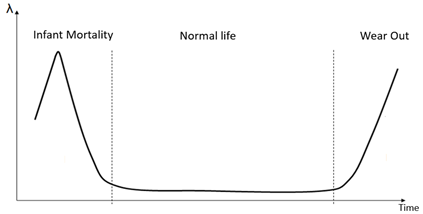Quality assurance (QA) occurs on many levels, the focus of this article is the quality assurance of the supplier or subcontractors for a project.
How does poor quality affect your project
All components roughly follow 3 life phases – Infant Mortality (IM), Normal Life (NL) and Wear Out (WO).
What characterizes each of the 3 phases are:
IM: Failure occurs in the early period of component life and is declining as poor-quality components fail
NL: Failures occur between IM and WO, they happen randomly and are typically caused by incorrect maintenance or environmental reasons – fx lightning strikes or damaged corrosion protection
WO: The whole population begins to fail as it reaches the age it is designed for
Poor quality is one of the main causes of IM failures, others are immature design or wrong handling. This article is about the first cause – poor quality.

Figure 1 shows the 3 component life phases.
IM may be due to a generally poor quality from a supplier or that the production processes are not sufficiently matured yet. Whether one or the other is the cause, a well-prepared and well-executed audit can help reduce the number of IM failures, thus protecting the project from unplanned downtime, thus increasing availability and last but not at least it also reduces OPEX.
An example of a supplier quality assurance approach
Quality assurance does not get better by sitting in the office writing requirements and conditions, you need to go where the products are produced, to get a feel for the quality level.
If it is an actual audit, it does not have to be against ISO 9001, I do reliability audits. Meaning I focus on the business processes and documentation that are important to support high quality with little variation and thereby reliable components, as well as the process steps involved in manufacturing the product.
There are three phases to go through in quality assurance, namely preparation, execution and reporting, and they must all be carefully planned.
The planning
During the planning phase, identify what is important in terms of high quality and reliability, how to evaluate it and how to conduct the audit. To prepare, I go through the following steps:
- Outlines process steps in the production flow – I make a process flow chart
- Assessing potential sources of variation – enemy of quality # 1
- Review known types of failures and analyze the causes that may arise from the production and mark them on my process flow chart
- Lists which process or quality assurance documents I would like to see and what I want to focus on
- What business processes I want to go through
- Makes a proposal for the execution of the audit, which is sent to the supplier to be audited
Finally, based on the above points, we make a component-specific questionnaire that is used during the audit.
Execution
In execution you visit the supplier, you may not be able to follow the plan you have set, so you must be prepared to be flexible so that you do not waste time. It takes place in two different parts, one in production and the other where system documentation is reviewed.
In production, I always follow the flow from incoming inspection to the final test, and sometimes conditions relating to storage and transport. In production, I especially follow up on the process steps where there have historically been problems or there is a risk of variation. In addition, I choose to follow some paper tracks and follow up on whether they follow their own procedures and if they seem robust, I ask some operators for things they need to know as well as follow up on data recording and how they are used.
In the system part of the audit, I follow up on some of the topics I have taken from production, delve into the business processes that are important to support high quality and the ability to work with continuous improvements, e.g. process descriptions for skills and training of employees, handling of deviations, root cause analysis, different types of statistics, PFMEA, supplier management, etc.
When the audit is over, all findings are reviewed with the supplier, and a timeframe is agreed within which he will return with descriptions of the corrective actions he will implement. If you cannot agree on the level, then you must deal with it as a risk in the project – that is, higher failure rates for IM.
Reporting
The reporting should give the project an insight into the weaknesses and threats identified by the supplier and suggestions on how to mitigate them. Some points may need to be added to the risk register. The report includes sections on:
- Strong and weak areas, a bit of a SWOT analysis
- Something about the general level
- Recommendations
- Appendix with all findings and associated modulation
Experience
CrossFields has broad experience in assessing components for the wind turbine industry, such as blades, pitch bearings, main bearings, gearboxes, generators, etc.
We also have extensive experience working in China, where we work with Chinese suppliers for the wind turbine industry.
If you have a project where you need an experienced auditor, contact CrossFields and hear about the options.
